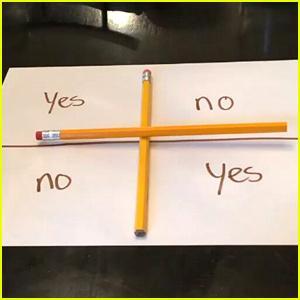A version of the Ouija board game is spreading like wildfire among children and young people via social media like Twitter.
It’s called the “Charlie Charlie Challenge,” allegedly named after a Mexican demon named Charlie.

The Daily Mail reports, May 26, 2015, that the newest fad for children and teenagers is to try to summon a Mexican demon. It involves writing “Yes” and “No” twice on a sheet of paper, crossing two pencils and then asking if the demon is present.
Game-players first chant “Charlie, Charlie, can we play?” twice, and wait to see if the crossed pencil points towards yes or no. If the pencils point towards yes, they ask the demon questions.
To end the game, they must ask permission to stop by chanting “Charlie, Charlie can we stop?” and wait until “Charlie” says yes by pointing the pencil to the correct square. Game-players must then drop the pencils to the floor so “the demon portal to his or her own home hasn’t been left wide open forever,” pencils.com reported.
People are filming and sharing their experiences of playing the game on Twitter.
Rumor has it the game, which has similar psychological effects as using a Ouija board, has ancient origins and that it’s almost a rite of passage for Mexican children to play it. It’s been reported that some children claim strange things have happened while playing the game, such as hearing laughter, or seeing bizarre shadows, while others have been left disappointed.
A priest in Philadelphia wrote an open letter to pupils at the Saints John Neumann and Mario Goretti Catholic High School warning them there is “no such thing as ‘innocently playing with demons’. Please be sure to NOT participate and and encourage others to avoid participation as well. The problem with opening yourself up to demonic activity is that it opens a window of possibilities which is not easily closed.”
The Independent says what’s actually moving the pencils is gravity, and the awkward positioning of some pencils. The pencils have to be so finely balanced on top of each other that even the slightest movement from a breath or slightly tilted surface will push it around. The arrangement of pencils that the game requires means that they’ll always move, because it’s just not a natural position for them to be in.
If you’d like to debunk the game for yourself, try doing the same thing without the paper and without the incantation. Pencils placed on top of and across each other always move around, whether or not a demon is summoned to push them.
In a report just 6 hours ago, the BBC says “More than 2 million people have used the hashtag #CharlieCharlieChallenge over the past 48 hours.
Maria Elena Navez of BBC Mundo disputes the claim that the game originated in Mexico: “There’s no demon called ‘Charlie’ in Mexico. Mexican legends often come from ancient Aztec and Maya history, or from the many beliefs that began circulating during the Spanish conquest. In Mexican mythology you can find gods with names like ‘Tlaltecuhtli’ or ‘Tezcatlipoca’ in the Nahuatl language. But if this legend began after the Spanish conquest, I’m sure it would’ve been called ‘Carlitos’ (Charlie in Spanish). Mexican demons are usually American inventions.”
Describing the game as a traditional Mexican way to summon the dead is probably a way to make it sound mysterious or meaningful – in the same way that the Ouija board has its roots in a clever bit of 19th century American marketing rather than ancient Egypt. Another possible explanation is a YouTube video posted a year ago which shows a slightly different pencil trick. It’s in Spanish, and its title translates as “Playing Charlie Charlie.”
Whatever the game’s origin, the players’ intent to summon demons is real. Please warn your children or grandchildren NOT to play it. There have been cases of demonic possession that began with playing the Ouija board, the most famous being the girl in the 1971 novel by William Peter Blatty which was made into the 1973 movie The Exorcist. Blatty’s novel was based on an actual 1949 exorcism of a young boy from Cottage City, Maryland.
See my post of Dec. 2, 2012, “What happened to the boy in ‘The Exorcist’.”
~Éowyn

